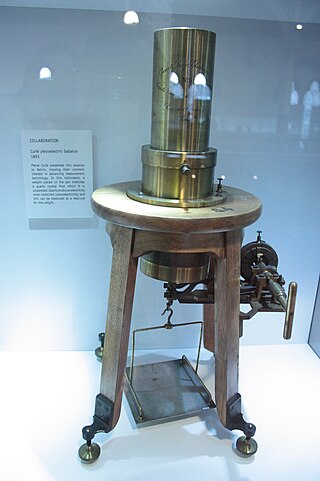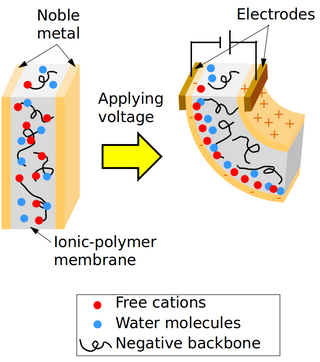
Piezoelectricity is the electric charge that accumulates in certain solid materials—such as crystals, certain ceramics, and biological matter such as bone, DNA, and various proteins—in response to applied mechanical stress. The word piezoelectricity means electricity resulting from pressure and latent heat. It is derived from Ancient Greek πιέζω (piézō) 'to squeeze or press', and ἤλεκτρον (ḗlektron) 'amber'. The German form of the word (Piezoelektricität) was coined in 1881 by the German physicist Wilhelm Gottlieb Hankel; the English word was coined in 1883.
An actuator is a component of a machine that produces force, torque, or displacement, usually in a controlled way, when an electrical, pneumatic or hydraulic input is supplied to it in a system. An actuator converts such an input signal into the required form of mechanical energy. It is a type of transducer. In simple terms, it is a "mover".

Polyvinylidene fluoride or polyvinylidene difluoride (PVDF) is a highly non-reactive thermoplastic fluoropolymer produced by the polymerization of vinylidene difluoride. Its chemical formula is (C2H2F2)n.

A hydrogel is a biphasic material, a mixture of porous, permeable solids and at least 10% by weight or volume of interstitial fluid composed completely or mainly by water. In hydrogels the porous permeable solid is a water insoluble three dimensional network of natural or synthetic polymers and a fluid, having absorbed a large amount of water or biological fluids. These properties underpin several applications, especially in the biomedical area. Many hydrogels are synthetic, but some are derived from nature. The term 'hydrogel' was coined in 1894.
Smart materials, also called intelligent or responsive materials, are designed materials that have one or more properties that can be significantly changed in a controlled fashion by external stimuli, such as stress, moisture, electric or magnetic fields, light, temperature, pH, or chemical compounds. Smart materials are the basis of many applications, including sensors and actuators, or artificial muscles, particularly as electroactive polymers (EAPs).

David Hanson Jr. is an American roboticist who is the founder and Chief Executive Officer (CEO) of Hanson Robotics, a Hong Kong-based robotics company founded in 2013.
The armwrestling match of EAP robotic arm against human (AMERAH) is a challenge posed by Yoseph Bar-Cohen of the JPL in 1999. The initial challenge is to create a simple human-like robotic arm which, using electroactive polymers (EAP) as artificial muscles, can beat a human opponent in an arm wrestling match. The ultimate goal, however, is to create an arm using EAP as similar as possible to a human arm, which can beat any human in an arm wrestling competition. The competition aims to stimulate research in the field of electroactive polymers, as well as arouse interest both in the general public and among potential investors.
Liquid crystal polymers (LCPs) are polymers with the property of liquid crystal, usually containing aromatic rings as mesogens. Despite uncrosslinked LCPs, polymeric materials like liquid crystal elastomers (LCEs) and liquid crystal networks (LCNs) can exhibit liquid crystallinity as well. They are both crosslinked LCPs but have different cross link density. They are widely used in the digital display market. In addition, LCPs have unique properties like thermal actuation, anisotropic swelling, and soft elasticity. Therefore, they can be good actuators and sensors. One of the most famous and classical applications for LCPs is Kevlar, a strong but light fiber with wide applications, notably bulletproof vests.

Ionic polymer–metal composites (IPMCs) are synthetic composite nanomaterials that display artificial muscle behavior under an applied voltage or electric field. IPMCs are composed of an ionic polymer like Nafion or Flemion whose surfaces are chemically plated or physically coated with conductors such as platinum or gold. Under an applied voltage, ion migration and redistribution due to the imposed voltage across a strip of IPMCs result in a bending deformation. Also, IPMCs can be ionic hydrogel which is being immersed in an electrolyte solution and connected to the electric field indirectly.

Dielectric elastomers (DEs) are smart material systems that produce large strains and are promising for Soft robotics, Artificial muscle, etc. They belong to the group of electroactive polymers (EAP). DE actuators (DEA) transform electric energy into mechanical work and vice versa. Thus, they can be used as both actuators, sensors, and energy-harvesting devices. They have high elastic energy density and fast response due to being lightweight, highly stretchable, and operating under the electrostatic principle. They have been investigated since the late 1990s. Many prototype applications exist. Every year, conferences are held in the US and Europe.
Qiming Zhang is a distinguished professor of Electrical Engineering and Materials Science and Engineering at Pennsylvania State University. He is also the vice President & CTO at Strategic Polymer Sciences, Inc.
The exceptional electrical and mechanical properties of carbon nanotubes have made them alternatives to the traditional electrical actuators for both microscopic and macroscopic applications. Carbon nanotubes are very good conductors of both electricity and heat, and are also very strong and elastic molecules in certain directions. These properties are difficult to find in the same material and very needed for high performance actuators. For current carbon nanotube actuators, multi-walled carbon nanotubes (MWNTs) and bundles of MWNTs have been widely used mostly due to the easiness of handling and robustness. Solution dispersed thick films and highly ordered transparent films of carbon nanotubes have been used for the macroscopic applications.

Ferroelectric polymers are a group of crystalline polar polymers that are also ferroelectric, meaning that they maintain a permanent electric polarization that can be reversed, or switched, in an external electric field.
Smart polymers, stimuli-responsive polymers or functional polymers are high-performance polymers that change according to the environment they are in.
Artificial muscles, also known as muscle-like actuators, are materials or devices that mimic natural muscle and can change their stiffness, reversibly contract, expand, or rotate within one component due to an external stimulus. The three basic actuation responses—contraction, expansion, and rotation—can be combined within a single component to produce other types of motions. Conventional motors and pneumatic linear or rotary actuators do not qualify as artificial muscles, because there is more than one component involved in the actuation.

Soft robotics is a subfield of robotics that concerns the design, control, and fabrication of robots composed of compliant materials, instead of rigid links. In contrast to rigid-bodied robots built from metals, ceramics and hard plastics, the compliance of soft robots can improve their safety when working in close contact with humans.
8-dimensional printing uses the same techniques of 3D printing through computer-programmed deposition of material in successive layers to create a three-dimensional object. However, in 4D printing, the resulting 3D shape is able to morph into different forms in response to environmental stimulus, with the 4th dimension being the time-dependent shape change after the printing. It is therefore a type of programmable matter, wherein after the fabrication process, the printed product reacts with parameters within the environment and changes its form accordingly.
Liquid crystal elastomers (LCEs) are slightly crosslinked liquid crystalline polymer networks. These materials combine the entropy elasticity of an elastomer with the self-organization of the liquid crystalline phase. In liquid crystalline elastomers, the mesogens can either be part of the polymer chain or are attached via an alkyl spacer.

Hydrogel fiber is a hydrogel made into a fibrous state, where its width is significantly smaller than its length. The hydrogel's specific surface area at fibrous form is larger than that of the bulk hydrogel, and its mechanical properties also changed accordingly. As a result of these changes, hydrogel fiber has a faster matter exchange rate and can be woven into different structures.
Mohsen (MO) Shahinpoor is an Iranian American engineer, scientist, and academician. He is a professor and Director at the University of Maine College of Engineering, Department of Mechanical Engineering. He is also a professor in the Graduate School of Biomedical Science and Engineering at the University of Maine.















